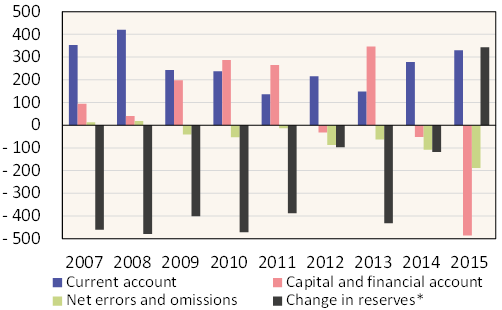BOFIT Weekly Review 16/2016
Capital inflows to China diminished last year, while capital outflows increased
Three weeks ago, China released complete balance-of-payments figures for 2015. The fi-nancial account showed that last year less capital flowed in and more capital flowed out of China than in recent years. Foreign portfolio investment flows to China fell sharply, and the Chinese increased purchases of securities abroad compared to earlier years. Depositors also took money out of China and foreign loans were paid back. Deregulation, China’s economic slowdown and the weaker growth outlook were the biggest factors in changes in capital flows.
The “net errors and omissions” item in the balance-of-payment ledger indicates capital movements not captured by official figures were larger than ever last year, with some $190 billion in unrecorded capital flowing out of the country. The estimate suggests the extent of efforts to circumvent capital controls. The flows of capital out of China clearly exceeded the current account surplus. This created depreciation pressure on the yuan’s exchange rate, which the People’s Bank of China offset with interventions in the forex market reducing China’s foreign exchange reserves by $340 billion.
The yuan’s exchange rate has seen little turbulence in recent months and China’s foreign currency reserves have remained basically unchanged. This indicates that the yuan no longer faces the same depreciation pressures as it did last autumn. China has also begun to publish more data than previously on the structure of its foreign currency reserves. It revealed, for example, its forex derivative position, which in net terms was relatively small at the end of February.
China’s balance-of-payments items, USD billion

Source: SAFE, *) A negative figure indicates net purchases of foreign currency and an increase in currency reserves.